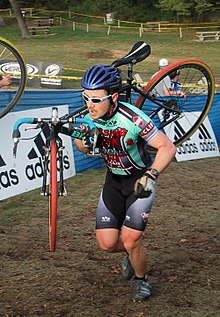Cyclo-cross racing
The cross-country race (also cyclocross , cyclocross or Switzerland Radquer ) is a discipline of cycling . The sport is played almost exclusively in autumn and winter on mostly unpaved roads. In contrast to the mountain bike sport , which has become more and more popular since the 1980s , cyclocross bikes with modified dimensions, i.e. more stable racing bikes with classic curved racing handlebars and without suspension, are used for cross-country skiing . The tires have different profiles and widths, but are consistently more profiled and wider than conventional racing bike tires. The sport is organized by the World Cycling Federation UCI .
history
The cross-country division had its origins on the French Riviera shortly after the turn of the century 1899/1900, when road riders built up their form in this area before the start of the season. They not only reeled off many kilometers, but also began to ride over hill and dale in order to improve their fitness, by no means avoided steep climbs and slopes and often shouldered their bikes. One day they set out a route in the field and on field and forest paths and staged a race. The first documented race took place on January 10, 1903 and was organized by Géo Lefèvre, who worked for Tour de France founder Henri Desgranges . In any case, it is guaranteed that the “Critérium international” was considered an international cross-country title fight on every first Sunday in March from 1924 to around 1948. The first national championship in Switzerland already existed in 1912. In France, cross-country races with competitive character were driven from 1909, the first winner of such a specialized race was Eugène Christophe , who also won several French championships in this discipline.
The first cyclo-cross world championships took place in Paris in 1950 . Since then, some well-known German road racing cyclists such as Klaus-Peter Thaler or Rolf Wolfshohl have been able to achieve the world championship title. Today some mountain bikers also ride cyclocross, some of them switch to cyclo-cross races in the winter season. A related example from the 1990s is the German Mike Kluge , who was both three-time cyclo-cross world champion and MTB world cup winner .
Currently (as of 2020) international cross-country sport for men is almost completely dominated by Belgium and the Netherlands . In the women's field, Hanka Kupfernagel was the first German to win the world title in 2000. She repeated her success in 2001, 2005 and 2008.
route
Cyclo-cross races usually take place on a relatively short, one to three kilometer circuit of field and forest paths. An otherwise completely unusual feature of the cross-country course in cycling are short, extremely steep passages that force the rider to dismount and carry the bike over the obstacle. In fact, the racer walking up a muddy slope with his bike shouldered is seen as the classic image of cross-country racing.
The duration of the race depends on the driver category and is between 20 and 60 minutes in the area of the Association of German Cyclists in accordance with the rules of the Union Cycliste Internationale. The number of laps to be driven is determined on the basis of the driving time of the leading driver after he has completed two complete laps. At the beginning of the third lap, the number of laps remaining to be driven is displayed on a board at the finish line. The last round is announced with a bell.
| category | male | Female |
|---|---|---|
| elite | 60 min | 40-50 min |
| U 23 | 50 min | 40 min |
| Masters | 40 min | 30 min |
| U 19 | 40 min | 40 min |
| U 17 | 30 min | 30 min |
| U 15 | 20 min | 20 min |
literature
- Pascal Sergent: Modder of Goud. De Wereldkampioenschappen cyclo-cross . Editions de Eeclonaar, Eeclo, 1996. (Flemish)
Web links
- Competition regulations for cyclo-cross racing, edition 03/2015 , Bund Deutscher Radfahrer (Ed.)
- UCI Rules Cyclocross
Individual evidence
- ↑ Market overview cyclocross tires. In: cx-sport.de. Retrieved May 3, 2015 .
- ↑ Hervé Paturle, Guillaume Rebière: Un siècle de cyclisme . Calmann- Lévy, Paris 1997, p. 48 (French).
- ^ Association of German cyclists (ed.): Radsport . No. 51/1950 . German sports publisher Kurt Stoof, Cologne 1950, p. 6 .

